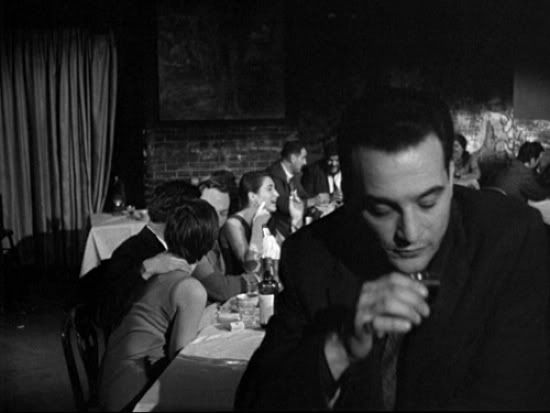
When did consciousness of the idea of film noir begin to affect filmmakers? There is a photo of Robert Aldrich in 1955 clutching a copy of Panorama du Film Noir, the first book-length work to address the subject. Certainly, Touch of Evil, made in 1958, seems self-consciously about its own style, but that may have more to do with Orson Welles than it does with noir.
The question comes somewhere in the 1960's--what is part of the original creative thrust of noir, and what is a self-conscious revival. And then one must separate the threads of which films are noir because that is the prevailing style of black-and-white crime films, and which films show evidence of having drunk the noir Kool-Aid. And I suppose if it's in color, such as Point Blank, it's neo-noir.
Clearly actor-director Allen Baron, knew what kind of film he was making with Blast of Silence (1961): A cheap but competently professional crime film suitable to be a calling card in the feature film business. An independent film scene was developing in New York at the time, most famously culminating in the films of John Cassavetes and Shirley Clarke. The resulting films are mostly theatrical in origin (not based on plays, but using the personnel and techniques of theater, especially improvisation), self-conscious and relating to the edgier aspects of downtown New York life--jazz, interracial love, gangs, drug addiction.
Blast of Silence is not having any. In fact, Frank Bono (pronounced "bon-no") might like to be part of the downtown scene. He might like to be part of any scene. But he's from out-of-town, he's alone for the Christmas season, just here to execute a hit and split. Forget all those depressed hippies, Bono is the definition of alienated.
I haven't actually been hired to kill someone (yet), but I have been alone in a city for a number of days at a time, and the film captures the boredom and isolation of that situation. And when Bono does have the opportunity to reach out to someone else he fumbles it. Which makes his own death logically right. Zero minus zero, nothing lost, the universe is still in balance. Barron's non-acting suits this perfectly. (Peter Falk, originally cast, would have been terrible, too ingratiating, too needy. Barron is a cipher, albeit an unhappy one.) The overwritten second-person narration (reportedly by a blacklisted Waldo Salt) is irritating at first, but you learn to tune it out--I almost wish Criterion could issue a version of the film without it.
A great deal of the contemporary pleasure of this film is seeing the New York locations, the Village, 125th Street, Rockefeller Center as they looked in the very early 1960s--some recognizable, some not. Shooting quick and dirty on the streets of the city means you don't have to actually have a cinematographic style. Those brightly lit yet dingy streets give you a production design and a shooting style by themselves--foreground objects and low key lighting not necessary (as Sweet Smell of Success demonstrated). Although there is an awe-inspiring shot as Barron approaches us from a long perspective, tiny at first, then filling the frame (my guess is it's East 34th Street near that large diagonally-placed building that sits on the corner of 34th and Park.)
Barron doesn't seem to have a great psychological or sociological point. It's a simple tale, crisply told. The best-laid plans and all that. The points make themselves via the pictures. And this Blast of Silence might be the last pure blast of noir before self-consciousness sets in.





No comments:
Post a Comment